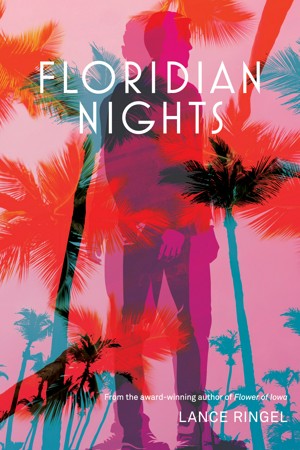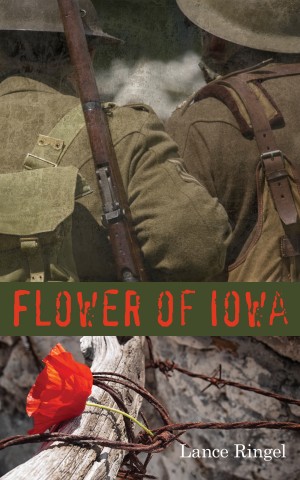Interview with Lance Ringel
Published 2014-05-05.
What was the inspiration for Flower of Iowa?
As a teenager, I was introduced to The Great War – as WWI is called in Europe – through two excellent sources: Barbara Tuchman’s masterpiece book The Guns Of August and a CBS-TV series called World War One. They both made a great impression on me, spurring a fascination with the war that changed our world so completely. Fast-forward three decades later. I was actually stuck in bed, recovering from a near-fatal bout of hepatitis, and the local PBS station began re-airing the CBS series. At the same time, controversy arose over Bill Clinton’s campaign promise to repeal “Don’t Ask, Don’t Tell.” I don’t know if it was inspiration or delirium, but an idea came to me: How about writing an historical novel in which two Great War soldiers fall in love? That hepatitis, I guess, was crucial to the genesis of my novel Flower of Iowa.
When did you start Flower of Iowa and how long did it take?
After I recovered, I spent the next six months researching the First World War, devouring everything I could learn about the battles, the generals, and above all the way people lived and died from 1914-1918. When I started this project, I quickly realized you can do one of two things with historical fiction: you can say, “Screw it, it’s fiction,” and completely use artistic license. Or you can try to make your story as plausible according to WWI history. I chose the latter route, which is much more work, but also much more fun.
But while being elbow-deep in books, articles, and photos, it dawned on me: I could spend the rest of my life researching and never writing a page. So I switched gears and started writing Flower of Iowa in spring 1993 while continuing to do research in libraries, in museums and on trips to Europe. (Friends claimed I got the idea just so I could travel to Europe!) I completed the first draft over the Atlantic, on a plane to London in the spring of 1997. Being a perfectionist, I have continued revising it for the last 17 years. But finally, with the centennial of the war upon us, it’s time to share Flower of Iowa with the world.
You embarked on an ambitious period of research for Flower of Iowa. How far did it take you?
My research took me across America and through Europe. To tell this story properly, I needed to see with my own eyes the actual Great War battlefields of France and Belgium, as well as their surrounding towns. I scoured Iowa to find the most suitable town to be Tommy Flowers’ birthplace – I settled on the village of Brooklyn. And being an old-school journalist, I sat for countless hours in libraries and museums on both sides of the Atlantic. The best source for my research was the extraordinary Imperial War Museum in London. The staff was immensely helpful to me, an American nobody who’d just wandered in. Within minutes, I was seated at a research table and was holding an original Great War trench map from 1918 – one that had been held by British soldiers. That just made my mind spin.
What was the greatest breakthrough in terms of researching Flower of Iowa ?
Serendipity followed me throughout this project. A friend from my junior high school days worked at the Illinois State Library. Once I established that the protagonist, Tommy Flowers, had to belong to the 33rd Division from Illinois, my friend tracked down a history of that group. But amazingly, she also uncovered a self-published book from a captain who fought with Tommy’s division in WWI. This man’s book, written in diary form, provided the perfect day-by-day structure for my fictional saga.
Another bit of serendipity brought about the creation of Sister Jean Anderson, the kindly nurse who ensures that love letters between Tommy and David are delivered safely and secretly. The inspiration for this pivotal character came during a flight home from Europe. I met a woman and told her about my book. It turned out that she possessed letters from her great-aunt who had been a nurse in the Great War. That treasure trove of letters helped me to accurately create Sister Jean.
What evidence is there of homosexual relationships during WWI?
There are plenty of tantalizing clues if you know where to look. The Great War and Modern Memory by Paul Fussell includes a chapter called “Soldier Boys” about homoeroticism in British literature about WWI. But since he wrote his book in the early 1970s, Fussell stressed the romantic nature of these relationships over actual sexual activity. Other evidence abounds: In Henry Berry’s oral history Make the Kaiser Dance, conservative Republican Congressman Hamilton Fish (a former Doughboy) noted that the Moroccans would not kill young German prisoners of war, but keep them “for boyfriends.” (I use this subplot in my novel.) Finally, the famous German scholar Magnus Hirschfeld, arguably founder of the modern gay movement, wrote a “Sexual History of the World War” in the 1930s that documented sexual activity between soldiers. Homosexual relationships in the Great War certainly happened, but were largely erased from history due to the mores of the time. I am happy to say that Flower of Iowa, although fictional, restores that part of history to our understanding of WWI.
How do you expect WWI history buffs to receive the book?
I expect the depiction of same-sex romance in Flower of Iowa will stir controversy, and very likely some negative reactions. I have been to various conferences and meetings of WWI aficionados. They’re a likable and smart bunch that can argue endlessly about the efficacy of U-boat warfare, whether the Schlieffen plan was really Germany’s blueprint for the war, etc. But they also have a strong tendency to conservatism, so I would expect some protest. While society colluded in making gay people invisible during most of the 20th century, the world has moved forward. I hope that WWI history buffs will appraise the book on its merits.
Is there a type of reader for whom you especially wrote Flower of Iowa?
I actually wrote it for mainstream American readers. Of course, if you are neither a mainstream reader nor American, I welcome you just as warmly. Europeans have a strong sense of how drastically the Great War changed their continent – and the world. But Americans are only dimly aware of its impact. I hope my novel will help others realize that LGBT people have always been part of society: as friend, neighbors, family members – and as soldiers fighting our wars alongside heterosexual comrades. What is worse than homophobia for me is the pernicious assumption that we simply do not exist.
Smashwords Interviews are created by the profiled author or publisher.
Books by This Author
Floridian Nights
by Lance Ringel
From the author of the award-winning Flower of Iowa: In 1988 NYC and Florida, a young gay widower confronts the twin challenges of overcoming his paralyzing grief while navigating an incipient romance with a man 13 years his junior.
Flower of Iowa
by Lance Ringel
(4.83 from 6 reviews)
Winner, Foreword Indies Book of the Year (Gold - War & Military Fiction); 2 IBPA Benjamin Franklin Awards (Gold - Fiction: Romance, Silver - LGBTQ); IPPYs Bronze Medal (Military/Wartime Fiction); Finalist, Lambda Literary Awards (Gay Romance)
France, 1918: American Tommy Flowers and Briton David Pearson face the challenges of trench warfare even as their friendship develops an unexpected intimacy


